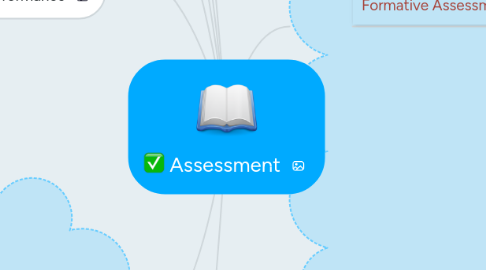
1. Interim/ Benchmark
1.1. Periodic testing throughout the school year
1.1.1. Six weeks testing
1.1.2. Chapter tests
1.2. Low level
1.3. Little or no student feedback
1.3.1. Student feedback is only given is the student is met with independently
1.4. More formal style like projects or written assignements
2. Summative
2.1. Planning summative assessments
2.1.1. Comes at the end of a unit
2.1.2. Review what you want to do
2.1.3. Criteria for ensuring high quality assessment
2.1.4. Representative sampling
2.1.5. Standardized tests, final exams, research projects
2.2. Preparing students
2.2.1. Teach assessment taking skills
2.2.2. Test length, format, types of questions
2.2.3. Review
2.2.4. Item type and format
2.2.5. Address how to deal with test anxiety
2.3. Conducting summative assessments
2.3.1. When they should be scheduled
2.3.2. When they should be created
2.3.3. Assessment directions
2.3.4. Arrange items
2.3.5. Physical layout
3. Performance
3.1. Individual
3.2. Group projects
3.3. Portfolios
3.4. Student logos
3.4.1. Graphing to show students where they are excelling
3.5. Journals
3.5.1. Reflect on different topics they excel in, and different topics they struggle in
4. Authentic
4.1. Not graded test, but real student work
4.1.1. Graded student work that is done in class
5. Multiple response formats
5.1. Assessing in different ways
5.1.1. running records
6. Standards based
6.1. TEKS
6.1.1. STAAR Test
6.2. Standards
6.2.1. District assessments
7. Reflective
7.1. Take ownership over their thinking
7.1.1. Look over their test and justify their answer choice through writing an explanation for why they chose that answer.
8. Formative Assessment
8.1. Definition: Process of gathering evidence of student learning.
8.2. Characteristics
8.2.1. Evidence of student learning
8.2.2. Participants involved feedback
8.2.3. Structure
8.2.4. Instruction adjustment
8.2.5. Teacher-student interaction
8.3. Occurs throughout the course of instruction
8.3.1. Examples of formative assessment
8.3.1.1. Thumbs up, thumbs down
8.3.1.2. Fist to 5
8.3.1.3. Exit ticket
8.4. 6 different types of formal formative assessment
8.4.1. Structured exercises
8.4.2. Pretest
8.4.3. Homework
8.4.4. In class assignments
8.4.5. Quiz and unit tests
8.4.6. Classroom response systems
8.5. Formative assessment cycle
8.5.1. 1. Gather evidence
8.5.2. 2. Evaluate evidence
8.5.3. 3. Feedback
8.5.4. 4. Adjust instruction
